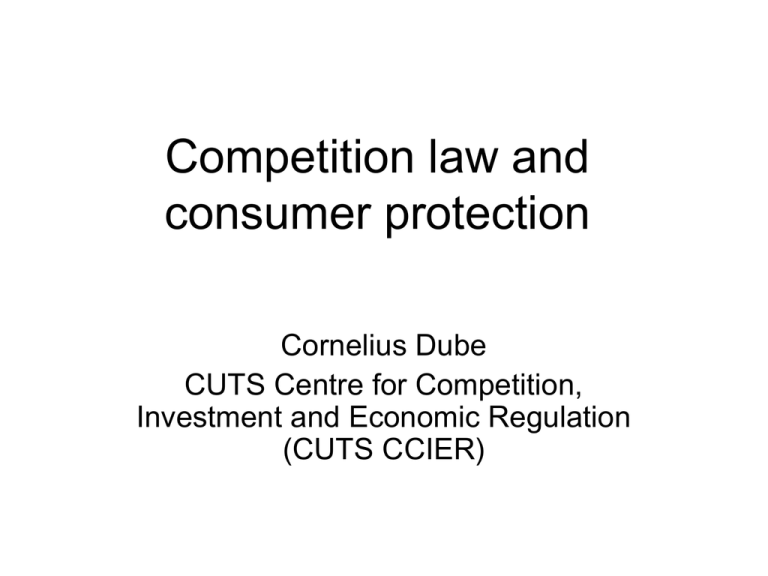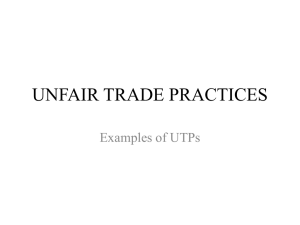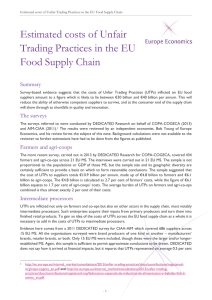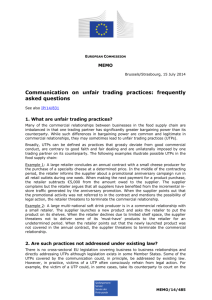Competition law and consumer protection
advertisement

Competition law and consumer protection Cornelius Dube CUTS Centre for Competition, Investment and Economic Regulation (CUTS CCIER) Outline • Consumer Welfare indicators • Competition law objectives and consumer welfare • Competition law and consumer rights • Competition law and consumer protection frameworks • Factors to determine frameworks • Recommendations 2 Consumer Welfare as satisfaction in trade • A consumer is generally satisfied in trade if happy with the following attributes: – Prices – Choices – Quality – Proximity • These can be used as acceptable measurements of consumer welfare • Can the implementation of a competition law assist in attainment of these four attributes? 3 Consumer welfare as attainment of basic rights • The Consumers International Charter recognises eight basic consumer rights as follows: – right to basic needs; – right to safety; – right to choice; – right to redress; – right to information; – right to consumer education; – right to representation; and – right to healthy environment • Can a competition law help in the attainment of any of these rights? 4 Competition law objectives and consumer welfare • Static Efficiency: – Lower prices – Better quality – More choice • Dynamic Efficiency: – Efficient allocation of resources – Management, processing and technological improvements – Product innovation • These objectives all have consumers as the ultimate beneficiaries and result in satisfaction in trade (consumer welfare) • Competition laws can be used to attain consumer welfare – Consumer interests are specific concern of EU Law – The UN Set of Principles and Rules on Competition has Consumer Welfare among its Objectives 5 Competition laws and consumer rights • The right to basic needs (through the price effects and increased production) and the right to choice are directly enhanced by competition law enforcement for all jurisdictions. • Some competition laws also include unfair trade practices (UTPs), which directly benefit consumers rather than indirectly. • In addition to the general issues such as bait and switch, misleading advertising etc, UTPs provision include issues addressing some basic rights such as: – obligations to indicate prices and terms of trade and prohibiting misleading advertising (right to information); – compensation for harmful and defective products (right to safety and right to redress); • Competition laws can also be used to attain some basic consumer rights • The recognition of the common objective has also given rise to operational framework questions 6 Competition and consumer protection frameworks • Hybrid laws, where the competition law also include provisions relating to consumer protection issues – E.g. Zambia, Zimbabwe and Tanzania also encompassed consumer protection issues under UTPs in the competition law • Hybrid agency, where there are two different laws on competition and consumer protection, but the laws are enforced by one institution. – Eg. The ACCC of Australia • Two separate institutions- competition authorities handling competition issues while consumer protection institutions handle consumer interest issues, including UTPs – India, CCI and CAT enforces Competition Act, 2002 while COPRA 1986 is enforced by a Central Consumer Protection Council. – South Africa, the Competition Commission and the Tribunal for competition Act, 1998 while a National Consumer Commission enforces the Consumer Protection Act. 7 Factors to determine frameworks • The country size and resources are sometimes used as the basis for choosing a framework. – For small economies, it is normally recommended that hybrid laws and agencies are more appropriate – Hybrid laws and agencies also save resources, and are also recommended for poor countries • Expertise considerations are also important – Most competition authorities lack the technical knowledge regarding the implementation of consumer laws, e.g. cheating on weights and measures; over-indebtedness of consumers; small-claims damage actions • Multiple agencies can give rise to conflicts, influenced by vested interest groups • Absence of perfect or total complementarity between the two policies imply difficulties in their implementation by one agency; conflicts are possible, e.g price controls. 8 Factors in choosing frameworks (cont..) • Establishing one comprehensive law to cover both competition and consumer issues is not an easy task- critical provisions in one or both may be left out. • Enactment might be easier compared to enforcement- having one regulatory authority in charge of two policies implying a multiplication of the implementation gaps for the two laws. • Line ministries may be different, e.g while competition authorities are largely hosted by the Ministry of Industry, consumer protection authorities may fall under the Ministry of social welfare/affairs. 9 Pros and Cons (Summary) Competition Authority for both laws Separate body for each law Pros Cons Avoidance of unnecessary clashes which delay implementation. May result in one party making decisions that negatively affect the interests of the other party, such as a consumer authority making decisions that negatively affect firms and competition. Allows the institution to make a balanced view by being conscious of the other law Costly to implement, as two separate organisations with their own budgetary requirements would need to be catered for. A cost saving measure, as it limits dependents on the national budget Cons Pros Lack of technical capacity to handle the two complex issues The set up allows each institution to handle issues for which it is best empowered. It allows for specialisation for the authority Challenges in the enactment of a comprehensive law which covers both issues without necessarily appearing contradictory Allows for extensive coverage of all issues to be dealt with in the consumer law, as focus would be totally on consumer law and not competition law Absence of total complementarity between the two policies also compromises their implementation by one institution Allows for the flexibility in both implementation and enactment of the consumer law, given that it given the consumer authority the freedom to act independently of the competition authority Consumer issues and competition authorities may not be under the ambit of the same Ministry Coordination with line Ministries will be much easier. Accountability to one Ministry also ensures less variance of objectives and vested interests. 10 Recommendations • Countries should choose a framework that is likely to bring the best outcome for both competition and consumer protection • The drafting of comprehensive laws is one of the most important aspect in ensuring better outcomes; this is best if separate laws exist • Ideally, both competition and consumer protection issues are too important issues requiring specialized skills for agencies- separate institutions could be better. • For small countries and most developing countries, it might be better to find ways of creating a hybrid agent which is very competent to handle both competition and consumer protection issues – Funding; separate departments to allow specialization; quality staff etc. 11 THANK YOU! cd@cuts.org C-cier@cuts.org 12











